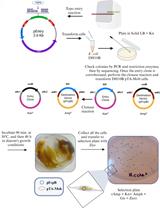- EN - English
- CN - 中文
Spatiotemporal Quantification of Cytosolic pH in Arabidopsis Pollen Tubes
拟南芥花粉管胞质pH的时空定量研究
发布: 2021年07月20日第11卷第14期 DOI: 10.21769/BioProtoc.4084 浏览次数: 3480
评审: Agnieszka ZienkiewiczElias Bassil
Abstract
Ion-specific probes and fluorescent indicators have been key in establishing the role of ion signaling, namely calcium, protons, and anions, in plant development, providing a robust approach for monitoring spatiotemporal changes in intracellular ion dynamics. The integration of protons/pH in signaling mechanisms is especially important as reports of their biological functions continue to expand; however, attaining quantitative estimates with high spatiotemporal resolution in single cells poses a major research challenge. Here, we detail the use of the genetically encoded pH-sensitive pHluorin reporter expressed in Arabidopsis thaliana pollen tubes to assess cytosolic measurements with calibration to provide actual pH values. This technique enabled us to identify critical phenotypes and establish the importance of tip-focused pH gradient for pollen tube growth, although it can be adapted to other experimental systems.
Keywords: Intracellular pH (细胞内pH值)Background
Fluorescent indicators and biosensors have been fundamental in establishing the role of ions and other molecules in the cell physiology of diverse biological systems. The development of a wide range of biosensors for monitoring ions, molecules, and even phytohormones in plants has greatly increased over recent decades (Hilleary et al., 2018; Walia et al., 2018). In particular, the spatiotemporal coordination of ion dynamics is essential for diverse cellular processes and signaling pathways. Genetically encoded probes such as the Ca2+ sensor CaMeleon have been extensively used to understand ion dynamics (Miyawaki et al., 1997; Nagai et al., 2004; Monshausen et al., 2008), which became an accessible tool through the generation of stable transgenic lines. The popularization of such approaches has allowed intracellular detection and monitoring, improving our understanding of the extensive role of Ca2+, especially in cell signaling, regulation, and communication (Feijó and Wudick, 2018; Walia et al., 2018). The specific expression of biosensors targeted to particular compartments or organelles, together with appropriate live-imaging and genetic tools, has led to the detection and visualization of Ca2+ waves in roots (Choi et al., 2014; Evans et al., 2016), propagation of electrical signals in leaves (Nguyen et al., 2018), Ca2+-based long-distance signaling (Toyota et al., 2018) and intercellular communication (Ngo et al., 2014). Addressing such phenomena at an organismal level elucidates how these signals are propagated, also showing the physiological integration across tissues and organs.
Although less understood than that of Ca2+, the role of pH in intracellular signaling has received increased attention, especially due to the fundamental nature of protons as water constituents and its function as a second messenger, as well as the calcium-proton interplay. Such implication is particularly relevant in pollen tubes, in which the intracellular pH is tightly regulated and the spatial gradient of cytosolic protons plays a major role in apical growth (Certal et al., 2008; Michard et al., 2008; Hoffmann et al., 2020). Substantial progress in the field has been supported by new methodologies enabling live-cell imaging with proper spatiotemporal resolution and timescales, while the quantification of intracellular ion concentration has been made possible by calibrating ratiometric probes with elevated signal-to-noise ratios and a suitable dynamic range of response. Ratiometric probes rely on a single fluorescent protein that emits different wavelengths when bound or unbound to a particular molecule/ion of interest. The ratio analysis is quantitatively reliable, allowing corrections related to image acquisition artifacts and differential expression levels of the probe throughout a cellular compartment. The present protocol describes the intracellular monitoring of protons in pollen tubes of Arabidopsis thaliana and the calibration procedure of the biosensor pHluorin (Miesenbock et al., 1998) after extraction of a cryptic intron and codon usage optimization (Hoffmann et al., 2020). To address the cytosolic proton dynamics in Arabidopsis pollen tubes, a stable transgenic line expressing the pH-sensitive ratiometric pHluorin was generated in wild-type and mutant backgrounds. The mutants investigated in Hoffmann et al. (2020) were of special interest for investigating H+ dynamics since they consisted of double- or triple-knockouts of H+-ATPases that sustained most of the H+ extrusion in the shank region of the pollen tube. The development of minimally invasive protocols enabling live imaging in pollen tubes showed a consistent spatiotemporal gradient, compatible with observations in other species, allowing the identification and characterization of mutant phenotypes (Michard et al., 2008; Certal et al., 2008; Hoffmann et al., 2020). The calibration protocol described herein required quantification of the respective signal coming from both emission channels while varying the cytosolic pH by exposing the biosensor to a diversified pH environment. Principles and experimental details described in the current protocol can be used and adjusted by other researchers to improve image acquisition procedures in diverse systems and calibration of distinct biosensors.
Materials and Reagents
Safe-lock tubes, 1.5 ml (Eppendorf, catalog number: 0030120086)
Glass-bottom dishes (ThermoFisher Scientific, catalog number: 150680)
Glass microfiber filters (Sigma-Aldrich, catalog number: WHA1820047)
Potassium chloride (Sigma-Aldrich, catalog number: P9333)
Magnesium sulfate (Sigma-Aldrich, catalog number: 746452)
Boric acid (Sigma-Aldrich, catalog number: B6768)
Calcium chloride (Sigma-Aldrich, catalog number: C1016)
HEPES (Sigma-Aldrich, catalog number: H3375)
Sucrose (Sigma-Aldrich, catalog number: S7903)
Nigericin sodium salt (Tocris Bioscience, catalog number: 4312)
Sodium phosphate dibasic (Sigma-Aldrich, catalog number: S8282)
Sodium phosphate monobasic (Sigma-Aldrich, catalog number: S7907)
Agarose low gelling temperature (Sigma-Aldrich, catalog number: A9045)
Germination medium (see Recipe 1)
Stock solutions (see Recipe 2)
Sodium phosphate buffer (see Recipe 3)
Calibration solution (see Recipe 4)
Equipment
Hot plate
pH meter
Vortex
Fine needle-sharp tweezers (Sigma-Aldrich, catalog number: WHA1820047)
Benchtop microcentrifuge (Eppendorf, model: 5415D)
DeltaVision Imaging System (Applied Precision - GE, model: Elite)
Note: Including an inverted microscope (Olympus, model: IX71), InsightSSI fluorescence illuminator, front-illuminated sCMOS camera (2560 × 2160, pixel size 6.45 μm), and 63 × 1.2 NA water immersion objective (Olympus, model: U-Plan S-Apo).
Filter sets, excitation 390/18 nm (DAPI) and 475/28 nm (FITC); emission, 435/48 nm (DAPI) and 523/36 nm (FITC)
Precise motorized X,Y stage
Software
ImageJ (Multiple Kymograph plugin), Fiji (https://imagej.net/Fiji/Downloads)
Statistical programming language R (R Core Team, 2020 – version 4.0.4 used here), RStudio recommended (RStudio Team, 2020 – version 1.4.1103 used here) and optionally, our custom-made analysis script CHUKNORRIS (Damineli et al., 2017)
Optional use of the custom R script ‘CalibrateFromKymographs.R’ supplied as Supplementary Material
Procedure
文章信息
版权信息
© 2021 The Authors; exclusive licensee Bio-protocol LLC.
如何引用
Portes, M. T., Damineli, D. S. and Feijó, J. A. (2021). Spatiotemporal Quantification of Cytosolic pH in Arabidopsis Pollen Tubes. Bio-protocol 11(14): e4084. DOI: 10.21769/BioProtoc.4084.
分类
植物科学 > 植物发育生物学 > 形态建成
生物物理学 > 显微技术
细胞生物学 > 细胞成像 > 荧光
您对这篇实验方法有问题吗?
在此处发布您的问题,我们将邀请本文作者来回答。同时,我们会将您的问题发布到Bio-protocol Exchange,以便寻求社区成员的帮助。
Share
Bluesky
X
Copy link












